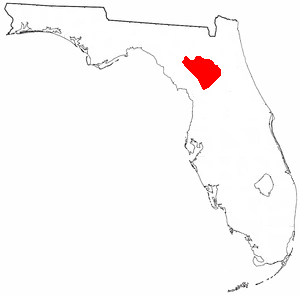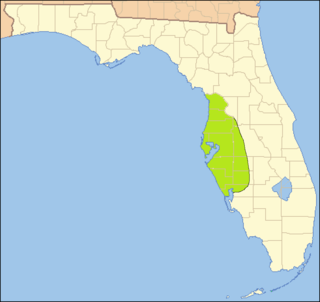The Calusa were a Native American people of Florida's southwest coast. Calusa society developed from that of archaic peoples of the Everglades region. Previous indigenous cultures had lived in the area for thousands of years.

The Florida Museum of Natural History (FLMNH) is Florida's official state-sponsored and chartered natural history museum. Its main facilities are located at 3215 Hull Road on the campus of the University of Florida in Gainesville.

The Weeden Island cultures are a group of related archaeological cultures that existed during the Late Woodland period of the North American Southeast. The name for this group of cultures was derived from the Weedon Island site in Old Tampa Bay in Pinellas County.

Horr's Island is a significant Archaic period archaeological site located on an island in Southwest Florida formerly known as Horr's Island. Horr's Island is on the south side of Marco Island in Collier County, Florida. The site includes four mounds and a shell ring. It has one of the oldest known mound burials in the eastern United States, dating to about 3400 radiocarbon years Before Present (BP). One of the mounds has been dated to as early as 6700 BP. It was the largest known community in the southeastern United States to have been permanently occupied during the Archaic period.

The Cades Pond culture is defined as a Middle Woodland Southeast period archaeological culture in north-central Florida, dating from around 100 to 600 CE.
The Belle Glade culture, or Okeechobee culture, is an archaeological culture that existed from as early as 1000 BCE until about 1700 CE in the area surrounding Lake Okeechobee and in the Kissimmee River valley in the Florida Peninsula.
The Caloosahatchee culture is an archaeological culture on the Gulf coast of Southwest Florida that lasted from about 500 to 1750 AD. Its territory consisted of the coast from Estero Bay to Charlotte Harbor and inland about halfway to Lake Okeechobee, approximately covering what are now Charlotte, Lee, and Collier counties. At the time of first European contact, the Caloosahatchee culture region formed the core of the Calusa domain.
Mound Key Archaeological State Park is a Florida State Park, located in Estero Bay, near the mouth of the Estero River. One hundred and thirteen of the island's one hundred and twenty-five acres are managed by the park system. It is a complex of mounds and accumulated shell, fish bone, and pottery middens that rises more than 30 feet above the waters of the bay.
The Big Mound Key-Boggess Ridge Archeological District is a historic site near Placida, Florida. It is located southeast of Placida, on Big Mound Key. On December 3, 1990, it was added to the U.S. National Register of Historic Places.
The Pineland Archeological District is a U.S. historic district located on Pine Island, near Pineland, Florida, and next to Pine Island Sound. The site was occupied by people of the Caloosahatchee culture, known as the Calusa in historic times, from 500 BCE until after 1700. The site includes shell and sand mounds and other structures and prehistoric canals and artificial lakes. It also includes structures from the late 19th and early 20th centuries.
The Turner River Site (8CR8) is an archaeological site in the Ten Thousand Islands region of Everglades National Park, in Florida. It is listed on the U.S. National Register of Historic Places.
Dismal Key is a small island, part of the Ten Thousand Islands archipelago in the Gulf of Mexico off the coast of Florida. The island is artificial, constructed by people of the Glades culture. Construction of the island proceeded in stages over some 1,500 years following the end of the Archaic period in Florida. Occupation probably ended a couple of centuries before the arrival of Europeans in Florida. Dismal Key was occupied by several hermits in the 20th century.
The indigenous people of the Everglades region arrived in the Florida peninsula of what is now the United States approximately 14,000 to 15,000 years ago, probably following large game. The Paleo-Indians found an arid landscape that supported plants and animals adapted to prairie and xeric scrub conditions. Large animals became extinct in Florida around 11,000 years ago.

The Safety Harbor culture was an archaeological culture practiced by Native Americans living on the central Gulf coast of the Florida peninsula, from about 900 CE until after 1700. The Safety Harbor culture is defined by the presence of Safety Harbor ceramics in burial mounds. The culture is named after the Safety Harbor site, which is close to the center of the culture area. The Safety Harbor site is the probable location of the chief town of the Tocobaga, the best known of the groups practicing the Safety Harbor culture.
Muspa was the name of a town and a group of indigenous people in southwestern Florida in the early historic period, from first contact with the Spanish until indigenous peoples were gone from Florida, late in the 18th century.
Fort Center is an archaeological site in Glades County, Florida, United States, a few miles northwest of Lake Okeechobee. It was occupied for more than 2,000 years, from 450 BCE until about 1700 CE. The inhabitants of Fort Center may have been cultivating maize centuries before it appeared anywhere else in Florida.

Shell works are large and complex assemblages of shell found in southwest Florida. Shell works include mounds and other deposits, with features described as borrow pits, canals, causeways, cisterns, crescents, sunken plazas, ponds, ramps, raised platforms, ridges, rings, walls, and "water courts". The largest shell works were constructed during the Woodland period in southwest Florida, from Charlotte Harbor to the Ten Thousand Islands, including Estero Bay.

The Pepper–Hearst expedition of 1895–1897 on the west coast of Florida was sponsored by Dr. William Pepper and philanthropist Phoebe Hearst, and led by the anthropologist Frank Hamilton Cushing. The pre–Columbian finds demonstrate a Shell Age phase of human development and culture.

The River Styx archaeological site is the site of a village and burial mound in North Central Florida that was occupied during the development of the Cades Pond culture out of the Deptford culture early in the Current Era (CE).
Cayo Pelau Archaeological Site is a multi-period aboriginal archaeological site in Charlotte Harbor on the west peninsular Gulf coast of the United States. The island is 3.5 miles directly south of the Big Mound Key-Boggess Ridge Archeological District. It is the only site that lies within two counties, Lee County in the south and Charlotte County, Florida to the north. Neither county has taken responsibility for identifying, protecting or preserving the prehistoric and historical cultural resources on the island.












